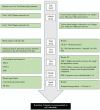Evidence of direct cardiac damage following high-intensity exercise in chronic energy restriction: A case report and literature review
- PMID: 28682862
- PMCID: PMC5502135
- DOI: 10.1097/MD.0000000000007030
Evidence of direct cardiac damage following high-intensity exercise in chronic energy restriction: A case report and literature review
Abstract
Rationale: Following prolonged endurance events such as marathons, elevated levels of cardiospecific biomarkers are commonly reported. Although transiently raised levels are generally not considered to indicate clinical myocardial damage, comprehension of this phenomenon remains incomplete. The popularity of high-intensity interval training highlights a paucity of research measuring cardiac biomarker response to this type of exercise. This a posteriori case report discusses the elevation of cardiac troponins (cTn) associated with short interval, high-intensity exercise.
Patient concerns: In this case report, an apparently healthy 29-year-old recreationally active female presented clinically raised cardiac troponin I (cTnI) levels (>0.04 ng/mL), after performing high-intensity cycle ergometer sprints. As creatine kinase (CK) is expressed by multiple organs (e.g., skeletal muscle, brain, and myocardium), cTnI assays were performed to determine any changes in total serum CK levels not originating from skeletal muscle damage.
Diagnosis: A posteriori the individual's daily energy expenditure indicated chronically low-energy availability. Psychometric testing suggested that the individual scored positive for disordered eating, highly for fatigue levels, and low in mental health components.
Outcomes: The current case report provides novel evidence of elevated cTnI occurring as a result of performing short duration, high intensity, cycle ergometer exercise in an individual with self-reported chronically depleted energy balance. A schematic to identify potentially "at risk" individuals is presented.
Lessons: Considering this as a case report, results cannot be generalized; however, the main findings suggest that individuals who habitually restrict their calorie intake below their bodies' daily energy requirements, may have elevated biomarkers of exercise induced myocardial stress from performing high-intensity exercise.
Conflict of interest statement
The authors have no funding and conflicts of interest to disclose.
Figures
Similar articles
-
Correlation of antemortem serum creatine kinase, creatine kinase-MB, troponin I, and troponin T with cardiac pathology.Clin Chem. 2000 Mar;46(3):338-44. Clin Chem. 2000. PMID: 10702520
-
Comparison of the diagnostic value of cardiac troponin I and T determinations for detecting early myocardial damage and the relationship with histological findings after isoprenaline-induced cardiac injury in rats.Clin Chim Acta. 2000 Aug;298(1-2):13-28. doi: 10.1016/s0009-8981(00)00223-0. Clin Chim Acta. 2000. PMID: 10876001
-
Cardiac troponin I is released following high-intensity short-duration exercise in healthy humans.Int J Cardiol. 2010 Nov 19;145(2):337-339. doi: 10.1016/j.ijcard.2009.12.001. Epub 2010 Jan 15. Int J Cardiol. 2010. PMID: 20079546
-
Creatine kinase monitoring in sport medicine.Br Med Bull. 2007;81-82:209-30. doi: 10.1093/bmb/ldm014. Epub 2007 Jun 14. Br Med Bull. 2007. PMID: 17569697 Review.
-
Early evaluation of myocardial injury by means of high-sensitivity methods for cardiac troponins after strenuous and prolonged exercise.J Sports Med Phys Fitness. 2020 Sep;60(9):1297-1305. doi: 10.23736/S0022-4707.20.11016-8. Epub 2020 Jul 23. J Sports Med Phys Fitness. 2020. PMID: 32720778 Review.
Cited by
-
Myocardial Performance in Elite Athletes: The Role of Homocysteine, Iron, and Lipids.Med Sci Monit. 2019 Feb 14;25:1194-1203. doi: 10.12659/MSM.913561. Med Sci Monit. 2019. PMID: 30760696 Free PMC article.
-
Exercise and COVID-19: exercise intensity reassures immunological benefits of post-COVID-19 condition.Front Physiol. 2023 May 5;14:1036925. doi: 10.3389/fphys.2023.1036925. eCollection 2023. Front Physiol. 2023. PMID: 37275224 Free PMC article. Review.
-
Pasture vs. Coop: Biomarker Insights into Free-Range and Conventional Broilers.Animals (Basel). 2024 Oct 24;14(21):3070. doi: 10.3390/ani14213070. Animals (Basel). 2024. PMID: 39518793 Free PMC article.
-
Sirtuins as Mediator of the Anti-Ageing Effects of Calorie Restriction in Skeletal and Cardiac Muscle.Int J Mol Sci. 2018 Mar 21;19(4):928. doi: 10.3390/ijms19040928. Int J Mol Sci. 2018. PMID: 29561771 Free PMC article. Review.
References
-
- Neilan TG, Januzzi JL, Lee-Lewandrowski E, et al. Myocardial injury and ventricular dysfunction related to training levels among nonelite participants in the Boston Marathon. Circulation 2006;114:2325–33. - PubMed
-
- Rifai N, Douglas PS, O’Toole M, et al. Cardiac troponin T and I, echocardiographic [correction of electrocardiographic] wall motion analyses, and ejection fractions in athletes participating in the Hawaii Ironman Triathlon. Am J Cardiol 1999;83:1085–9. - PubMed
-
- Shave R, Oxborough D. Exercise-induced cardiac injury: evidence from novel imaging techniques and highly sensitive cardiac troponin assays. Prog Cardiovasc Dis 2012;54:407–15. - PubMed
-
- Hickman PE, Potter JM, Aroney C, et al. Cardiac troponin may be released by ischemia alone, without necrosis. Clin Chim Acta 2010;411:318–23. - PubMed
-
- Collinson PO, Gaze DC. Biomarkers of cardiovascular damage and dysfunction—an overview. Heart Lung Circ 2007;16(13 suppl):S71–82. - PubMed
Publication types
MeSH terms
Substances
LinkOut - more resources
Full Text Sources
Other Literature Sources
Medical
Research Materials



